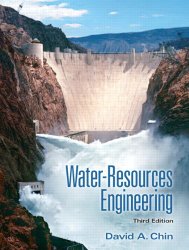Engineering Bookshelf
- Aerospace
- Biological
- Civil
- Chemical
- Environmental
- Electrical
- Materials
- Mechanical
- Petroleum
- Geoengineering
- Software

Water-Resources Engineering
by David A. ChinPublisher: Prentice Hall; 3 Edition
ISBN: 0132833212
Check price @ amazon.com , amazon.ca , amazon.co.uk
From Book News, Inc.
Water-Resources Engineering provides comprehensive coverage of hydraulics, hydrology, and water-resources planning and management. Presented from first principles, the material is rigorous, relevant to the practice of water resources engineering, and reinforced by detailed presentations of design applications. Prior knowledge of fluid mechanics and calculus (up to differential equations) is assumed.
Chin (civil and environmental engineering, U. of Miami) presents beginning undergraduate students with a picture of water-resources engineering that integrates fundamental concepts of fluid mechanics, water treatment processes, hydraulics, hydrology, and contaminant fate and transport processes. He incorporates and explains the core design principles of water distribution, sanitary sewer, stormwater management, and water-quality control systems.
Book Info
Provides a complete picture of water-resources engineering by integrating the fundamental concepts of fluid mechanics, hydraulics, hydrology and containment transport processes. DLC: Hydraulics.
From the Inside Flap
Water-resources engineering is concerned with the design of systems that control the quantity, quality, timing, and distribution of water to support both human habitation and the needs of the environment. Water-resources engineers are typically trained in civil or environmental engineering programs and specialize in a variety of areas, including the design of water-supply systems, water and wastewater treatment facilities, irrigation and drainage systems, hydropower systems, and flood-control systems.
The technical and scientific bases for most water-resources specializations are found in the areas of fluid mechanics, hydraulics, hydrology, contaminant fate and transport processes, and water-treatment processes. Many engineering schools classify water treatment processes as a subject that belongs to environmental engineering rather than water-resources engineering; however, a holistic view of the practice of water resources engineering supports the study of water-treatment processes as part of both water-resources and environmental engineering specialties. The pigeonholing of fluid mechanics, hydraulics, hydrology, and contaminant fate and transport into discrete subjects, usually taught in separate courses using different textbooks, has resulted in large part from the extensive knowledge base that has developed in each of these areas and the commensurate specialization of engineers involved in research and academic practice. Engineering students are consequently left with a sense of compartmentalization and intimidation.
Typically, they fail to see the complete picture of water-resources engineering and view each specialty as so vast that mastery at the undergraduate level is impossible. To address this misperception, an integrated treatment of water-resources engineering must necessarily present the fundamental aspects of the field while providing sufficient detail for the student to feel comfortable and competent in all the areas covered. Such an integrated approach has been taken in preparing this text, resulting in a book that covers the topics most fundamental to the practicing water-resources engineer and does so with sufficient rigor that further instruction, whether at the graduate level or in professional journals, can be assimilated at a high technical level....
Customer Reviews
A reader from Miami, Florida
This book should be on the bookshelf of every engineer who specializes in water-resources engineering.